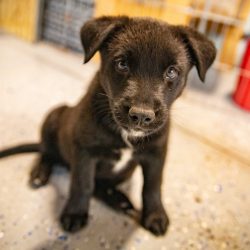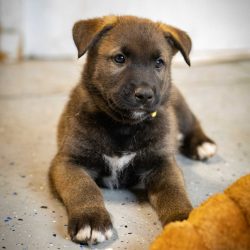There’s no doubt that animal control suffers a bad, often villainous reputation in popular culture: imagine the cartoon stereotype of the obese, net-wielding dog catcher. This impression of animal control taints real-life interactions, and can be a barrier to accessing valuable services that get animals the help they need. Here, volunteer Dean cuts through the misinformation with a tour of Edmonton’s new Animal Care and Control (ACCC) facilities.
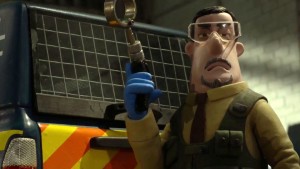
Trumper, the villainous animal warden from Shaun the Sheep.
My adventure at the Edmonton Animal Care and Control Centre (ACCC) actually began with a really bad day the week of Christmas 2015. I’d lost kitten a few months ago and have visited there several times, and I’d already seen several nasty rumors about the ACCC on FaceBook. This struck me as very odd, as the people spreading those rumours were also animal rescuers and I’d never had a bad experience during my dozen or so visits to the ACCC before.
I knew there was a serious problem, though, after I dropped off a female stray cat and her two kittens. The person I was helping broke off contact with me when she found out I’d taken them to the ACCC. Another person on FaceBook saw their pictures and told me that since the kittens were huddled in the back of the cage, they would be considered “unadoptable” and were probably already euthanized. And then another person I’d helped suddenly decided she’d rather privately adopt out her kittens, rather than take them to the ACCC.
I had questions that needed answers. Fortunately, the ACCC’s customer service manager was happy to oblige, and offered me and another Zoe’s volunteer a tour of the new facilities.
Not your stereotypical Pound
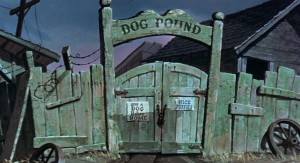 The first thing I’ve always noticed at the ACCC is the lobby – the new place is inviting. Unlike the old “Edmonton Pound” with its one long counter, the lobby is divided into intake area and pickup areas with a winding wall partially separating the two. The seats are comfortable, the greenery is lush, and the flat screen TV shows some hilarious animal pictures as well as helpful advice. The kennels that were so prominent in the old facility are nowhere in view – they’ve been replaced with a row of transfer cages and bays for pet carriers. These were installed to prevent animals from escaping in the lobby area and the system works very well.
The first thing I’ve always noticed at the ACCC is the lobby – the new place is inviting. Unlike the old “Edmonton Pound” with its one long counter, the lobby is divided into intake area and pickup areas with a winding wall partially separating the two. The seats are comfortable, the greenery is lush, and the flat screen TV shows some hilarious animal pictures as well as helpful advice. The kennels that were so prominent in the old facility are nowhere in view – they’ve been replaced with a row of transfer cages and bays for pet carriers. These were installed to prevent animals from escaping in the lobby area and the system works very well.
“Cats go in the front, dogs in the back.” I’m told. Being more of a cat person, that just seems right to me.
Tammy and I head to a conference room where some of the management and technical staff spend the next 90 minutes answering dozens of my questions about how the facility works.
Euthanasia rates? 16% of cats (down from 25% in 2013), and 2% for dogs (down from 6% in 2013)
Shelter capacity? 116 cats and 50 dogs, but this capacity can be increased in case of a sudden intake (e.g. a hoarding bust).
Does the ACCC take volunteers or fosters? No, but people can volunteer through the Edmonton Humane Society (EHS) and other rescue organizations.
Do you only work with EHS? No – the ACCC works with several other rescues as well, especially with animals that don’t meet the EHS adoptability criteria.
The list of questions goes on (so many that they will be presented as FAQs in upcoming posts). All of my questions are answered respectfully and professionally, and often enthusiastically.
And then it sinks in: these aren’t the typical bureaucratic shelter workers you hear about in horror stories on the Web. They’re 100% dedicated animal lovers, and they do all they can to reunite lost animals with their owners. They’ve seen more animal neglect and abuse than most of us would ever care to imagine. Yet they keep at it day after day because they genuinely care about the animals in their facility.
Just before the interview ends and the actual tour begins, the staff drops a bit of a bombshell: the ACCC just launched its own FaceBook page. This was fantastic news to me – not only will the new page address a lot of those nasty rumors I’d read, but it gives them another way to reach out to the owners of lost pets. I’m smiling when we start the tour.
The Surgical Suite
The ACCC’s new surgical suite looks clean and really top-notch – on par with every well-equipped vet hospital I’ve ever seen and more. The suite is a primary vet care facility which can handle everything from emergency surgery and wound repair, emergency spay/neuter and orthopedic surgeries (such as setting broken legs and pelvic bones), to quill removal, frostbite injuries, and dental operations. Today its only animal resident is a friendly white-and tabby cat with frostbite injuries. She seems to be recovering nicely with the exception of the tips of her ears, which are missing. The staff has saved many animals with more severe injuries, though, such as dogs with multiple broken bones from being struck by cars. Before the suite went into operation, saving such animals would have been much more difficult, if not impossible.
Dog Kennels
 The dog kennels are unexpected. The first thing I notice is the smell. It neither stinks nor smells like harsh cleaners, but simply smells a bit like “dog”. The lighting is subdued, there’s a whiff of aromatherapy in the air, and there’s relaxing music piping through hidden speakers. Dogs housed here get a clean bed and blanket, food, water, and at least one new toy a day. They also get lots of attention on a number of dog runs (indoor and outdoor), plus an indoor treadmill. It isn’t a dog spa, but it’s a far cry from the overcrowded, filthy shelters sometimes portrayed in the media, where animals have been known to have been warehoused in kennels without food, water or care. The ACCC’s kennels can even be subdivided by sliding panels to increase the shelter’s capacity in case of a sudden intake of animals.
The dog kennels are unexpected. The first thing I notice is the smell. It neither stinks nor smells like harsh cleaners, but simply smells a bit like “dog”. The lighting is subdued, there’s a whiff of aromatherapy in the air, and there’s relaxing music piping through hidden speakers. Dogs housed here get a clean bed and blanket, food, water, and at least one new toy a day. They also get lots of attention on a number of dog runs (indoor and outdoor), plus an indoor treadmill. It isn’t a dog spa, but it’s a far cry from the overcrowded, filthy shelters sometimes portrayed in the media, where animals have been known to have been warehoused in kennels without food, water or care. The ACCC’s kennels can even be subdivided by sliding panels to increase the shelter’s capacity in case of a sudden intake of animals.
I hear a few dogs, but I’m not surprised I don’t see any. It’s mid-January and most responsible pet owners are keeping pets indoors because of the sub-zero weather. When I checked their website an hour before the tour there were only 6 dogs at the facility (and that’s an encouraging thought!) Some of them are in the area reserved for aggressive dogs, and that’s understandably off-limits to the public.
Cat Kennels
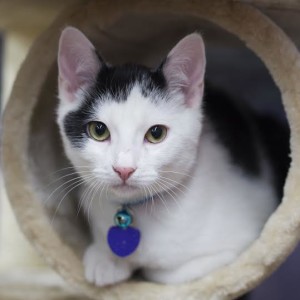 The cat kennels are just as clean and just as impressive. Like the dogs, cats get a clean bed and litter, food, water, and at least one new toy a day. Plus, they also have an “Enrichment Room” where they get lots of play daily. In fact, when we visit the Enrichment Room, there’s a staff member playing with a big black cat using a feather wand from a big wall cabinet full of toys. The cat (named Oscar) is having a lot of fun, and I’m surprised to find out he’s 17 years old.
The cat kennels are just as clean and just as impressive. Like the dogs, cats get a clean bed and litter, food, water, and at least one new toy a day. Plus, they also have an “Enrichment Room” where they get lots of play daily. In fact, when we visit the Enrichment Room, there’s a staff member playing with a big black cat using a feather wand from a big wall cabinet full of toys. The cat (named Oscar) is having a lot of fun, and I’m surprised to find out he’s 17 years old.
I notice a couple of other differences with the cat areas. The first difference saddens me – there are far more cats in this facility than dogs. Secondly, while there are more cats here, most of them have names. Those names come from their IDs, tattoos, and microchips, and from hours of searching by staff members. This is responsible pet ownership at its best, and I’ve no doubt that most these lost cats will soon be going home to their owners simply because they decided to microchip their pets.
Happy Endings
Our tour comes to an end and I’ve got more than enough information for a handful of posts, but I’m leaving with something more: hope. I’ve seen firsthand that the ACCC isn’t a “high-kill” shelter by any means, and the rumors I’ve read were just that and nothing more. In fact, without actively pursuing it, the ACCC is very close to meeting “No Kill” criteria.
And the bad day that started all of this? That’s all it was – they happen. But the next time I rescue animals (lost pets or otherwise), I know where to go, and I know they’ll be in good hands.
